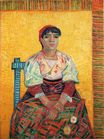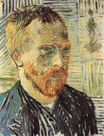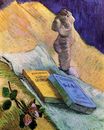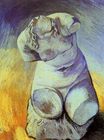Винсент Ван Гог - Итальянка. Агостина Сегатори 1887
 |
 |
 |
 |
 |
 |
 |

Итальянка. Агостина Сегатори 1887
81x60см холст/масло
Musée d'Orsay, Paris, France
<< Previous G a l l e r y Next >>
From the Musée d'Orsay, Paris, France:
This woman is without doubt Agostina Segatori (1843-1910), a former model of Corot, Gérôme and Manet with whom Van Gogh seems to have had a brief love affair a few months before this portrait was painted. During his time in Paris, between March 1886 and February 1888, he was initiated into the scientific colour-theories developed by the Neo-impressionists. He was also profoundly interested in Japanese etchings, and in this portrait, Van Gogh offers a very personal synthesis of these two influences.
Several elements are reminiscent of Japanese prints: the asymmetrical border, the stylisation of the character in a portrait with neither shadows nor perspective, the monochrome background… But instead of the refined touch of Eastern aesthetics Van Gogh employs an energetic treatment, which results in an impression of almost primitive might.
The Neo-impressionists juxtaposed complementary colours in order to achieve intensity. Here, Van Gogh did likewise, associating reds with greens and blues with oranges but instead of the pointillist brush-stroke characteristic of Seurat and Signac, he uses a criss-cross of overlapping nervous hatching. The colours are violent, expressive, revealing Van Gogh to be a precursor of Fauvism.
Agostina Segatori's face, in which red and green prevail, is an incarnation of the artist's objective, verbalised a year later in Arles: "to be able to express the terrible passions of humanity by means of red and green".